 IES SPRING SEMESTER 2008
IES SPRING SEMESTER 2008 IES SPRING SEMESTER 2008
IES SPRING SEMESTER 2008
| AH331 - XVIth and XVIIth
century Art and Papal Patronage
|
|
| Prof. Irene Baldriga - Prof. Pier Paolo Racioppi | |
|
|
|
|
Part I - Part II - Part III - Part IV - Part V - Part VI - Part VII Required and Suggested Readings General bibliography on the topic Further information (field trips, exams, etc.)
|
|
| Part I. Introduction to the course. Ruling Christendom between Renaissance and Baroque (1 week). | |
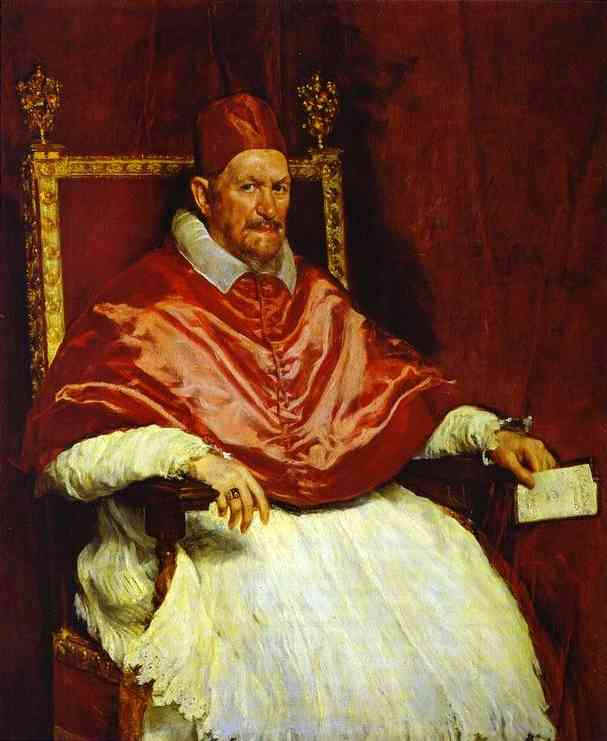 |
Presentation of the main topics of the course and of
the required readings. The course will start with an historical
introduction to the period which will primarly highlight the role played
by the Papacy within the European international context. A brief analysis
of the Reformation crisis and of the Counter-Reformation, with their many consequences in
the field of art history, will help students to acquire a general idea of
the historical background treated by the course.
|
| Part II. The Pope as a Patron (2 weeks). | |
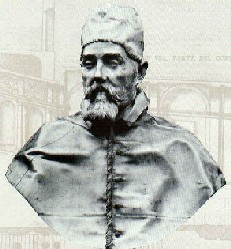 |
Analysis of the main character of the course: the
Pope, with regards to his functions, strategies and court life. As rulers without heirs and as shepherds of souls,
Popes instituted a kind of patronage which had no comparisons. The tension
and contradictions between private and public goals will be examined, as
well as the peculiarities of papal patronage (definition of typologies of
works of art best preferred by Popes, affinities and differences in
comparison to Aristocratic patronage). General considerations on the type
of Papal Portrait; Funeral Monuments, Official Sights (St. Peter; Vatican
Palaces; Castel Sant’Angelo; the Lateran Basilica).
|
| Part III. Working for St. Peter’s heir: some exemplary cases (2 weeks). | |
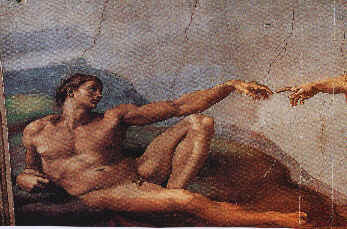 |
This part of the course will be focused of the
extraordinary relationships established between Popes and some artists:
Julius II and Michelangelo; Leo X and Raphael; Urbano VIII and Bernini.
Documentary and Literary references will be used in class in order to
better understand the psychological involvements and the mutual benefits
characterizing the contacts among these characters.
|
| Part IV. Divine Inspirations: patronizing the Arts in the name of God. (2 weeks) | |
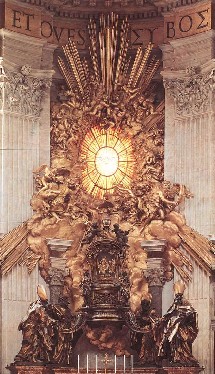 |
Analysis of the enterprises promoted by Popes who showed exceptional sensibility to the propagandistic power of the Arts: Julius II della Rovere; Paolo III Farnese; Sisto V Peretti; Gregory XIII Boncompagni; Urbano VIII Barberini. Particular attention will be given to the importance of Jubilees as crucial occasions or artistic promotion.
|
| Part V. Disputing about the Arts: Reformation, Counter-Reformation and the question of Religious art (1 week). | |
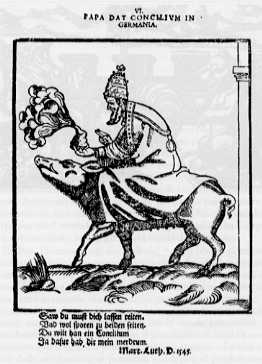 |
The unusual case of Pope Adrian VI from Utrecht. Martin Luther’s attack against the Catholic Church: the iconoclastic crisis in Northern Europe. Short analysis of the artistic issues discussed by the Council of Trent and of Gabriele Paleotti’s Trattato sulle Immagini Sacre e Profane. Birth of new religious orders and consequent changes in religious art goals. New architectural patterns for new religious orders: The Jesuit Order and the Chiesa del Gesù; the Oratorians and the Collegio dei Filippini. |
| Part VI. A cultural melting pot: Rome between Renaissance and Baroque (2 weeks). | |
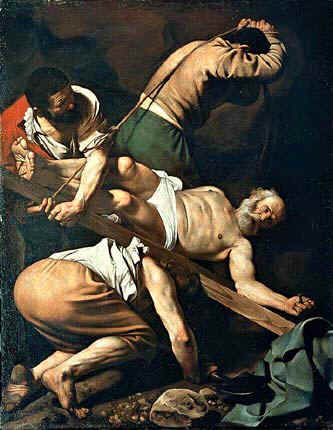 |
The presence of the Pope and his court made of Rome one of the most important artistic centers of Europe, not to mention the importance of a sensible private patronage. Many artists moved here looking for wealthy patrons ready to finance new works of art. A general survey of the city of Rome as capital of the arts during XVIth and XVIIth century and an analysis of some of the most important artists who chose it as their temporary or definitive residence. The “Clementine style” (before the sack of Rome); Caravaggio and the Caravaggist movement. |
| Part
VII. Shaping the Capital of Christendom: Baroque magnificence for the city
of the Pope (1 week).
|
|
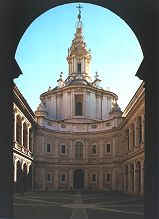 |
A short analysis of the most important urbanistic changes promoted by Popes in the city of Rome. Particular attention will be given to the works of Bernini and Borromini.. |
|
Tools and purposes of art history. Studying art history in Rome. Libraries and historical archives. |
|
|
|
|
|
|
A tentative class outline will be handled to students at the beginning of the course, with a schedule of lectures and assignments. Any changes will be announced in class. |
|
|
|
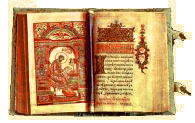 |
A deep knowledge and assimilation of the readings is considered as a fundamental part of the course. Superficial approaches to the texts will affect the final grade. Students are warned that the exams will be based both on our class discussions and on the contents of the readings. Most of the readings will be available in photocopies. As for the recommended readings, some of them are available at our library (IES office). Some of the readings will be available in photocopies. As for the suggested readings, some of them are available at our library (IES office). |
| Required readings (1 and 2):
1) Books: L. Partridge, The Art of Renaissance Rome, Prentice Hall, 2006, ISBN-10 0131344005 Rome. Art and Archaeology (ed. by Andrea Augenti), Scala Group, Firenze 2003 (only the chapters on Renaissance and Baroque, pp. 105-223). ISBN: 1-878351-56-7 Ch. Avery, D. Finn, Bernini: genius of the Baroque, Thames & Hudson (November 15, 2006) ISBN: 0500286337 2) Reader (photocopies from IES Library): R. Wittkower, Art and Architecture in Italy: 1600 to 1750. I. Early Baroque, revised by Joseph Connors and Jennifer Montagu, Yale University Press, Pelican History of Art, 1999, ISBN: 0300079397 (pp. 1-40) Rejoice! 700 years of Art for the Papal Jubilee (ed. Maurizio Calvesi), Rizzoli: New York, 2000 (pp. 9-40; 57-70; 93-104; 143-168). Some further readings will be provided in photocopies during the course. Recommended Readings: F. Haskell, Patrons and Painters. A Study in the Relations between Italian Art and Society in the Age of the Baroque, New Haven and London 1980 Nicola Courtright, The Papacy and the art of reform in sixteenth century Rome. Gregory XIII's Tower of the Winds in the Vatican, Cambridge University Press, 2003. General bibliography on the topic of Papal Patronage: The literature on the topic of papal patronage is huge. The following list is not meant to be exhaustive, but can be a useful reference for a deeper analysis of the issues treated by our course. Jh. Beldon Scott, "Papal patronage in the seventeenth century: Urban VIII, Bernini, and the countess Matilda" in L'âge d'or du Mécénat (1598-1661): actes du colloque international CNRS (mars 1983) ; le mécénat en Europe, et particulièrement en France avant Colbert / réunies et publiés pour le compte de la Société d'étude du XVIIe siècle par Roland Mousnier et Jean Mesnard, Paris : Editions du Centre National de la Recherche Scientifique, 1985, pp. 119-127. J. Shearman, "The Vatican Stanze: functions and decoration" in Proceedings of the British Academy, 57, 1972. M.J. Zucker, "Raphael and the beard of Julius II" in Art Bulletin, 59, 1977. L. Partridge and R. Starn, A Renaissance Likeness. Art and Culture in Raphael's Julius II, 1980. T. Magnuson, Rome in the age of Bernini, 2 voll, 1982. S. Boorsch, The building of the Vatican: the papacy and architecture, New York, 1983. The Vatican Collections: the Papacy and art, New York, Abrams, 1983. H. Wohl, "Papal patronage and the language of art: the pontificates of Martin V, Eugene IV and Nicholas V" in Umanesimo a Roma nel Quattrocento, a cura di Paolo Brezzi, 1984, pp. 235-246. R. Krautheimer, The Rome of Alexander VII, 1655-1667, 1985. C. Johnston, "The rôle of papal patronage in Italian baroque art" in Vatican Splendour: masterpieces of baroque art (eds. Catherine Johnston ; Gyde Vanier Shepherd ; Marc Worsdale), National Gallery of Canada, Ottawa, Ottawa, 1986, pp. 15-28. F.W. Kent and P. Simons (eds), Patronage, Art and Society in Renaissance Italy, 1987. P. Prodi, The Papal Prince. Papal Monarchy in early modern Europe, 1987. C.L. Frommel, "Papal policy: the planning of Rome during the Renaissance" in R.I. Rotberg and T.K. Rabb (eds), Art and History, 1988. J. Freiberg, "The Lateran patronage of Gregory XIII and the holy year 1575" in Zeitschrift für Kunstgeschichte, 54, 1991, pp. 66-87. W. Reinhard, "Papal patronage and family strategy in the XVIth and XVIIth centuries" in R. Asch, A. Birke (eds), Princes, Patronage and the Nobility. The Court at the beginning of the Modern Age, 1991. J.B. Scott, Images of Nepotism. The Painted Ceilings of Palazzo Barberini, 1991. M. Wamke, The Court Artist, 1993. T.M. Marder, Bernini's Scala Regia at the Vatican Palace, Cambridge University Press, 1997. F. Hammond, Music and Spectacle in Baroque Rome: Barberini Patronage under Urbano VIII, 1994. L. Smith Bross, "Patronage and propaganda at S. Spirito in Sassia: the role of a papal confraternity" in Confraternite, Chiese, Società, a cura di L. Bertoldi Lenoci, 1994, pp. 87-103. M. Hollingsworth, Patronage in Renaissance Italy: from 1400 to the Early XVIth Century I (1994); Patronage in XVIth century Italy II (1996), London. I. D. Rowland, The culture of the High Renaissance, 1998. Court and Politics in Papal Rome 1492-1700 (ed. M.A. Visceglia), Cambridge 2002. T. Weddingen, Functions and decorations art and ritual at the Vatican Palace in the Middle Ages and the Renaissance, Firenze, Opuslibri, 2002. Literature in Italian: M. Calvesi, Le arti in Vaticano, Nuova ed.Milano: Fabbri, 1980. L'arte dei papi : come pontefici, architetti, pittori a scultori costruirono il Vaticano, monumento della cristianità, a cura di Maurizio Fagiolo Dell'Arco, testi di Angela Cipriani, Milano: Mondadori, 1982. G. Alciati, I papi costruttori: storia e arte di Roma dall'Umanesimo al Barocco, Roma : Leonardo, 1990. Innocenzo X Pamphilj : arte e potere a Roma nell'età barocca, a cura di Alessandro Zuccari e Stefania Macioce, Roma: Logart Press, 1990. Arte a Roma : pittura, scultura, architettura, nella storia dei Giubilei, a cura di Maurizio Calvesi con la collab. di Lorenzo Canova, Milano: Rizzoli, 1999. La storia dei giubilei, Banca Nazionale del Lavoro. Comitato scientifico : Claudio Strinati, Progetto editoriale e cura : Gloria Fossi, Roma : BNL Edizioni, 1997 - 2000. – Vol. 1 - 4. Roma felix : la città di Sisto V e Domenico Fontana, a cura di Leros Pittoni e Gabrielle Lautenberg, Roma: Viviani, 2002.
Class
time:
Monday (Baldriga, in classroom) and
Thursday Virtual Classroom: go to www.irenebaldriga.it/patronage_virtual.htm Required
work and form of assessment:
Class attendance and participation (15%); midterm (20%); research paper
(30%); final exam (35%). Final exams will be based on both the course
lectures and the assigned readings. Grading:
the final grade will be based on the exams, the paper and class
participation (which requires that students attend class). Format
of the exams:
Mid-term and Final exams will consist of multiple choice questions; true/false
questions; short answers. The results of the mid-term and of the research
papers (if possible also the final) will be discussed privately. Research paper: the research paper will be focused on the presentation of a work of art (painting; sculpture or building) to be chosen from a list suggested by the teacher. By examining a specific work of art, main goal of the student should be making logical connections to the main topics treated in class. It is mandatory to know directly the painting/sculpture/building which is the object of the paper. The research paper may be of approximately 4-5, pages, possibly typewritten and double spaced with footnotes, bibliography and (if possible) illustrations. An elementary bibliographic research is required. Presentations of the paper in class are welcome and may involve the attribution of extra-credits to be considered in the final grade.
Visits to monuments and sightseeing: Field studies will mostly take place on Thursday's, with Prof. Racioppi. Their attendance is considered part of the course; as a consequence, subjects discussed during the field studies will be considered as part of the exams. For a detailed schedule, see the outline of the
course. Students are strongly encouraged to visit on their own sights and monuments treated by the course which, for evident didactic reasons and lack of time, it will not be possible to visit together.
|
|
|
|
|